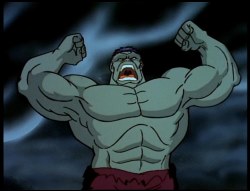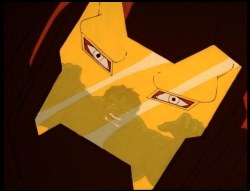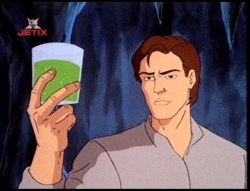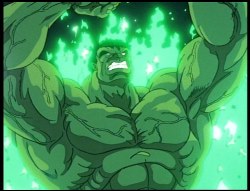 |
|
· Bios · Episode Guide · Episode Reviews · Archives · Interviews · DVDs · Titles · Downloads · Message Board · MAA Home Page
 |
|
|
Sebast: I had done work in the past for the show’s executive producer, who asked me to produce and direct the show. My job was to oversee most of the creative aspects of the show—the overall look, character and background design, storyboard, sound design, etc.--within concepts and limits established by the network, Marvel, and the studio.
MAA: The show featured a glutton of guest stars both new to Hulk and characters that had appeared on previous Marvel cartoons. How important was it to you to maintain continuity between the shows?
 Sebast: I guess I would have to say I was ambivalent to those other series. I think a show should be approached on
it’s own terms unless it is deliberately designed to be part of a series of interconnected shows. The studio
(New World Animation, now defunct) had previously done Iron Man and Fantastic Four series under other producer/directors.
We used character models and vocal talent from those shows when they appeared, partly for continuity, and partly for as
a production convenience, but we did not look beyond New World’s own product. At the end of the day, the executive
producer and myself felt more compelled to maintain a touchstone with the original source material—i.e. the comics—than
with other cartoon adaptations
Sebast: I guess I would have to say I was ambivalent to those other series. I think a show should be approached on
it’s own terms unless it is deliberately designed to be part of a series of interconnected shows. The studio
(New World Animation, now defunct) had previously done Iron Man and Fantastic Four series under other producer/directors.
We used character models and vocal talent from those shows when they appeared, partly for continuity, and partly for as
a production convenience, but we did not look beyond New World’s own product. At the end of the day, the executive
producer and myself felt more compelled to maintain a touchstone with the original source material—i.e. the comics—than
with other cartoon adaptationsMAA: Are there any stories you wish you could’ve told but never could?
Sebast: The executive producer already had a concept for the show, which was to start with the origin of the Hulk and loosely parallel the comic book evolution of the Hulk over the show’s run (we set up the Gray Hulk at the end of the first season to play a prominent role in season two, for example.) To that end, he and the head writer, Greg Johnson, pretty much worked out the plot outlines. I would read the outlines and scripts and make notes, of course, but my arena was largely in translating the stories to the screen.
 MAA:Did you ever see the previous 1982 Hulk cartoon? If you did, what did you draw from the series, if anything?
MAA:Did you ever see the previous 1982 Hulk cartoon? If you did, what did you draw from the series, if anything? Sebast: I was working at Marvel Productions when that series was being produced, but I was attached to Spiderman and His Amazing Friends. Other than having checked some Hulk layouts during a production crunch, I really don’t remember much about it.
MAA: The show was one of the darkest cartoons of the 1990’s, a time when censorship was running throughout animation. Did BS&P ever cause you any great amount of trouble?
Sebast: No more than any other action-adventure show of the period. Maybe less. The Hulk’s outlandish strength and abilities demanded he be paired with bigger-than-life adversaries, which usually translated to big machines, or formidable monsters. BS&P tended to focus more on violence against humans or animals.
MAA: The show mixed parts of the live action TV series and the comic books. How familiar were you with both properties, and how important to you was it to remain ‘faithful’ to the original interpretations?
Sebast: I had watched the old TV series on a more-or-less regular basis, but I was not familiar with the Hulk comics. (The superheroes of my youth pretty much occupied the DC universe. Marvel was just coming into its own about the time I was drifting away from comic books in my late high school/early college years.) When I came to the series, I read as many of the “essential” Hulk stories as I could to familiarize myself with the seminal material As I mentioned earlier, the executive producer wanted to do the “classic” Hulk, and I concurred, so I guess I would have to say that the comics were the more important influence. The live action series did leave its mark on the cartoon, though, with Lou Ferrigno voicing the Hulk.
 MAA: An odd question, but were there ever any plans for Spider-Man to make an appearance? He seemed to be the only important guest star the show didn’t have. Was there a particular reason he didn’t appear?
MAA: An odd question, but were there ever any plans for Spider-Man to make an appearance? He seemed to be the only important guest star the show didn’t have. Was there a particular reason he didn’t appear? Sebast: Not that I recall. I suspect (and I’m only guessing) that animation rights for Spider-Man were tied up.
MAA: On a similar note, Wolverine was originally supposed to appear in the Wendigo episode. What prevented his appearance? What did you have planned for the character?
Sebast: Wow! Now you’ve really stumped me. I don’t remember any such plans for him in that episode. It may have been considered very early by the writer, but I’m pretty sure the written premise that came to me didn’t include Wolverine. If in fact the intention had been there, I suspect the exclusion may have been due (again) to the unavailability of licensing rights
 MAA: Were The Hulk’s previous animated appearances on Iron Man and Fantastic Four problematic for you in any way?
MAA: Were The Hulk’s previous animated appearances on Iron Man and Fantastic Four problematic for you in any way? Sebast: Nope. We had our sights set squarely on doing “classic” Hulk from scratch
MAA: How much did the toy-line affect the show, in both writing and production?
Sebast: Other than working in a vehicle or prop from the toy-line on occasion, I don’t recall any significant impact on our overall concept or storyline
 MAA: What happened in season 2? Why did the quality drop to such a low level?
MAA: What happened in season 2? Why did the quality drop to such a low level? Sebast: Well, this cuts to the heart of a not uncommon problem in this business. The UPN executive assigned to the show really had no feeling for what the Hulk was about or what was most important to an action-adventure show in general, or to Marvel fans in particular. (There were a host of creative differences, but what I most remember of those network meetings was her obsession with fashion—she kept insisting that everyone look like they just-stepped out of a shop on Rodeo Drive—hardly a look that would fit any of the main characters.) Anyway, to cut to the chase, let’s just say that the episodes delivered to network tended to reflect the creative choices of the production company over those of network. (See what’s coming…?)
Cut to season 2. The axe falls. The edict came down from network that the show would be pulled from New World unless there were a change of creative personnel who would toe the line; so the second season got a new producer, director and crew. Not unexpectedly, I never viewed any of the second season episodes, so I’ll accept your assessment of the overall quality.
What happened to season 2? The network got its way.
MAA: If you had been given full control, how would you have ended the show?
Sebast: I don’t think I can really answer that. As I said earlier, the plan had been to roughly follow the evolution of the Hulk comics as the show progressed throughout its run. We had never viewed it as a finite entity like a miniseries with a pre-defined ending, so how we would have ended it would have depended on where we were in the Hulk mythology, or where the evolution the series had taken us when the last season loomed.
MAA: Are you happy with the episodes overall? Did you accomplish everything you wanted to?
Am I happy with the episodes overall? That’s a toughie. I haven’t seen them since their initial run while still in the heat of production. With television animation there’s almost always disappointment for me when the film first comes back because no matter how many series I do, my expectations always outrun the reality of the medium. Seen through the prism of time, however, my opinion is usually kinder. Just the same, I wish the animation were better. The overseas studio we used was better suited to comedy than action-adventure, but the better studios were overloaded at the time we had to commit. Like any series, you’re usually finding your legs in the first season, so I’d have to say, no, I didn’t accomplish everything I would have liked, but then I never got the chance to “kick it up a notch” in the second season.
The Marvel Animation Age would like to thank Dick Sebast for taking the time to do this interview. Cheers Dick!
